To Aleppo With Love – Za’atar Halabi
September 30th, 2016
Aleppo is the famous city of Za’atar, one of the most important blend of any Syrian home’s pantry.
Aleppian Za’atar has a different element from other neighboring countries. It is based on mixture of crushed spices and roasted nuts mixed with sumac and toasted sesame seeds. The blend of ingredients varies from one spice dealer, or ‘Attar to another.
Za’atar Halabi is usually prepared in September, and because it is widely available commercially people do not bother making it at home. In Aleppo, people used to buy Za’atar from Al-Madina Souq which is now destroyed and burnt as result of the war.
Za’atar Halabi is always a part of Syrian breakfast table. It is eaten by dipping a piece of bread in olive oil first then dipping it in Za’atar. Za’atar Halabi is not used for manakish (only Jordainen, Palestenian, and Lebanese Za’atar are used for manakish).
Let’s make Za’atar Halabi:
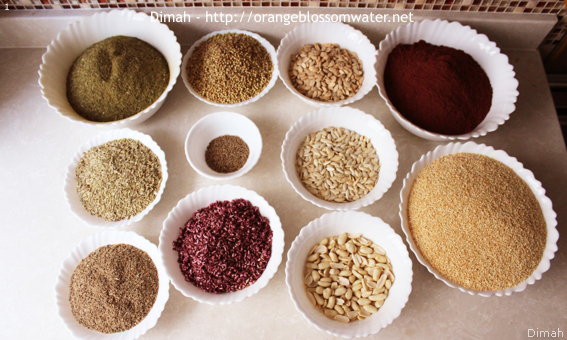
1. Ingredients of Za’atar Halabi are: thyme, fennel seeds, anise seeds, coriander seeds, cumin seeds, pomegranate seeds, watermelon seeds, sweet melon seeds, peanuts, ground sumac, and sesame seeds.
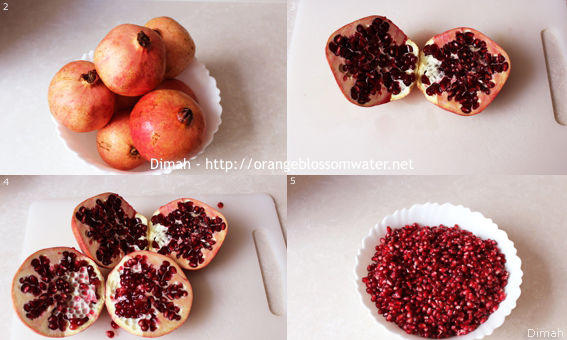
Qurtum (should be prepared few days in advance)
Qurtum is dried pomegranate seeds, it is used as ingredient in Za’atar.
1, 2. Bring sour pomegranates, then cut in half crosswise.
3, 4, 5. Then, working over a large bowl and holding one pomegranate half cut side down, smack the fruit with wooden spoon to loosen and release seeds into the bowl.
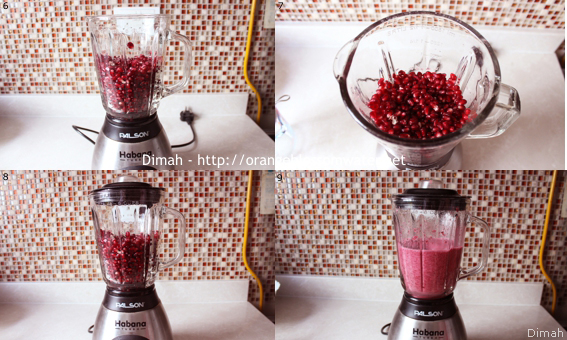
6, 7. In a blender, add pomegranate seeds.
8, 9. Run your blender few times
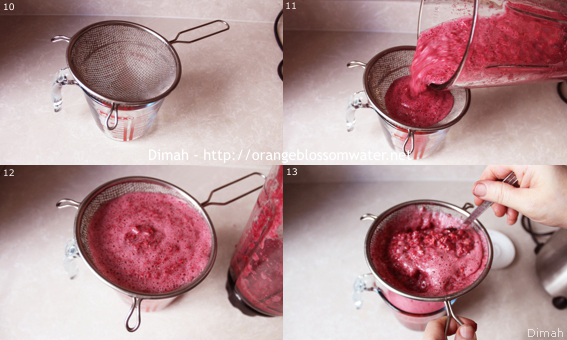
10, 11. Place a stainless steel mesh strainer over your bowl and pour the seed mixture through the strainer.
12, 13. Use a spoon to press the pulp against the strainer to extract as much juice as possible.
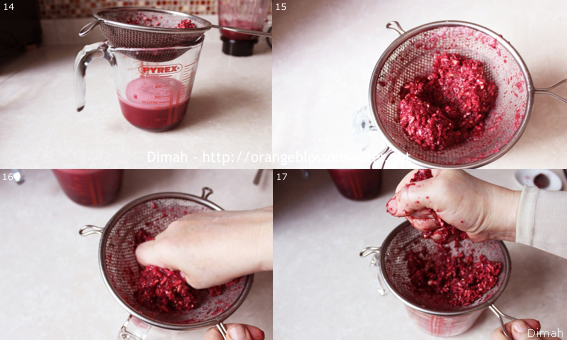
14, 15, 16, 17. Use your hand and squeeze until you get all juice out.
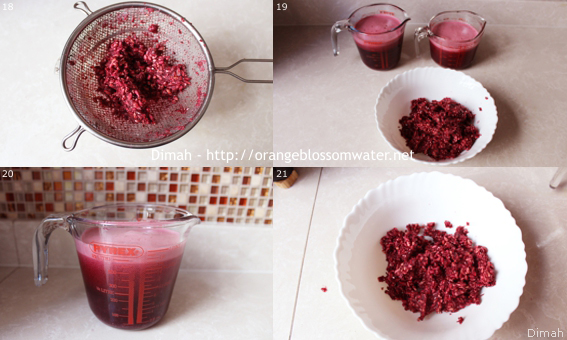
18, 19, 20, 21. Only seeds are used for Za’atar. Store pomegranate juice for other use.
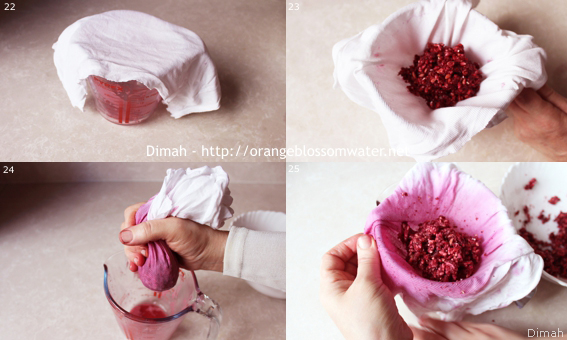
22, 23, 24, 25. Line a jug with a clean cotton cloth and put the pomegranate seeds inside the cloth, wrap it and squeeze until you get all juice out.
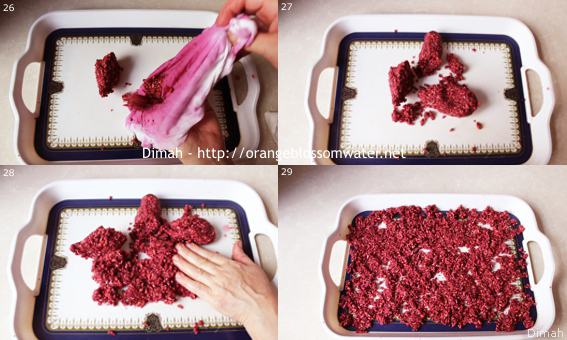
26, 27, 28, 29. Arrange the pomegranate seeds in a single layer on a tray.
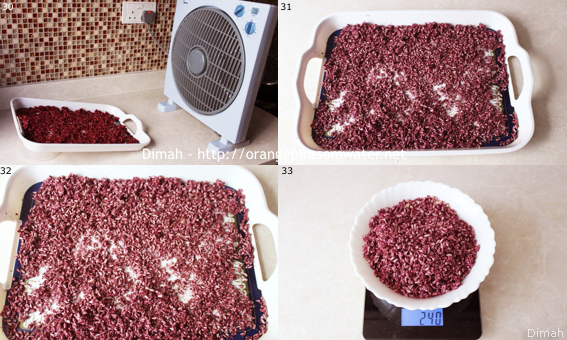
30, 31, 32. Put the trays in front of a fan for 24 hours or until seeds dried.
33. 240 g of dried pomegranate seeds is used for the recipe, set aside.
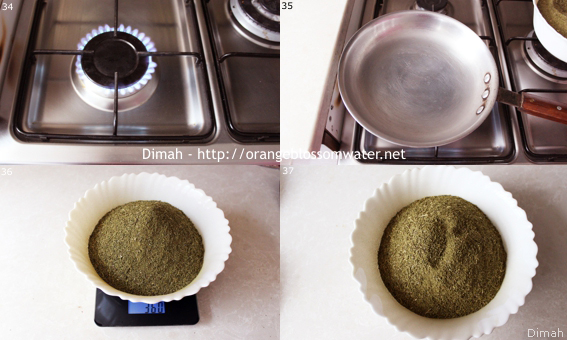
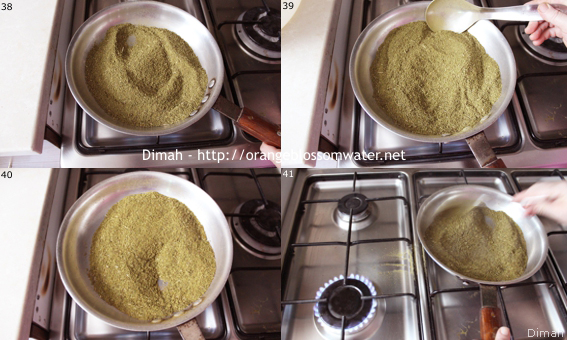
Making Za’atar Halabi
34, 35. Put aluminum pan over medium heat.
36, 37, 38. To the pan, add in batches 360 g dried thyme.
39, 40. Stir continuously until very fragrant and turn into light brown in color. Be careful not to turn the color into very dark brown.
41. When needed, remove from heat for seconds but keep stirring it. This helps to cool it for a little and to prevent burning, then return it back to heat.
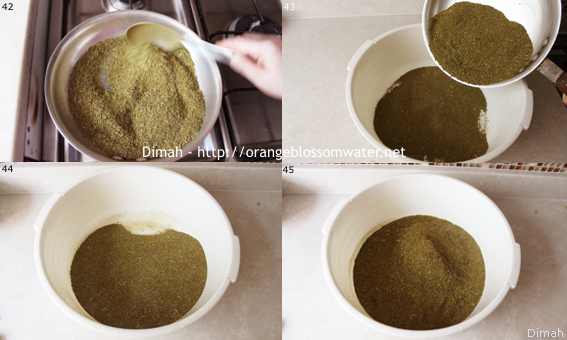
42. Roasting dried thyme (from step 38 – 42) took 3 minutes and 30 seconds for each batch.
43, 42, 43. Transfer roasted thyme into a large bowl, and set aside.
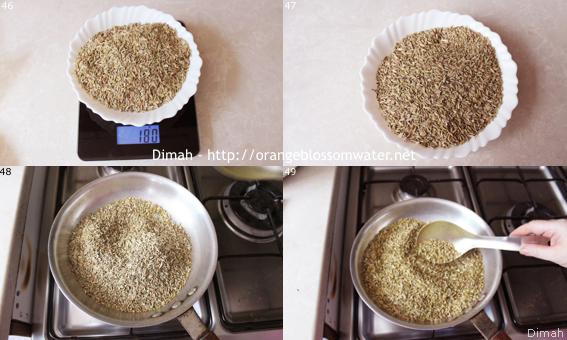
46, 47, 48. To same pan and over medium heat, add 180 g fennel seeds.
49. Stir continuously until fragrant and slightly change in color. Be careful not to burn or change the color too much.
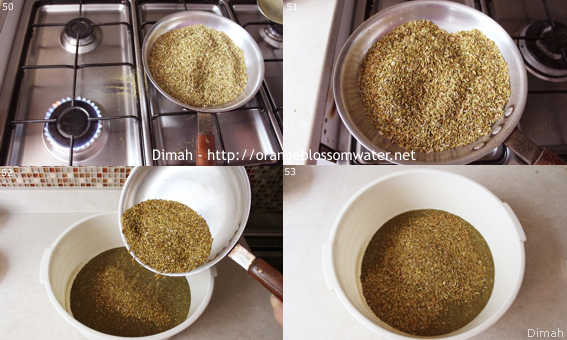
50. When needed, remove from heat for seconds but keep stirring it. This helps to cool it for a little and to prevent burning, then return it back to heat.
51. Roasting fennel seeds (from step 48 – 51) took 4 minutes.
52, 53. Transfer roasted fennel seeds to the same bowl of thyme, and set aside.
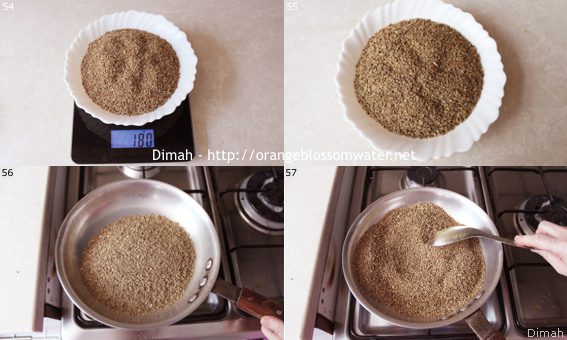
54, 55, 56. To same pan and over medium heat, add 180 g anise seeds.
57. Stir continuously until fragrant and slightly change in color. Be careful not to burn or change the color too much.
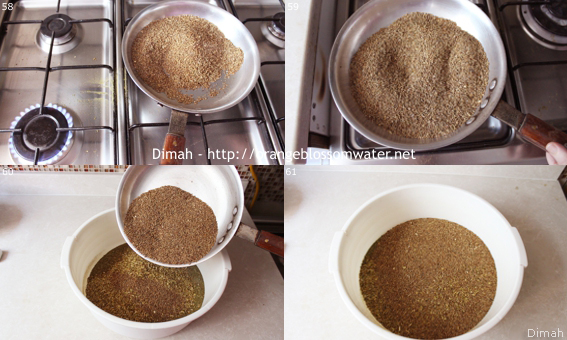
58. When needed, remove from heat for seconds but keep stirring it. This helps to cool it for a little and to prevent burning, then return it back to heat.
59. Roasting anise seeds (from step 56 – 59) took 3 minutes and 15 seconds.
52. Transfer roasted anise seeds to the same bowl of thyme, and set aside.
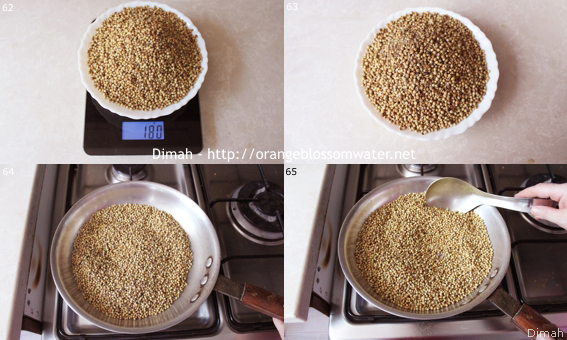
62, 63, 64. To same pan and over medium heat, add in batches 180 g coriander seeds.
65. Stir continuously until fragrant and slightly change in color. Be careful not to burn or change the color too much.
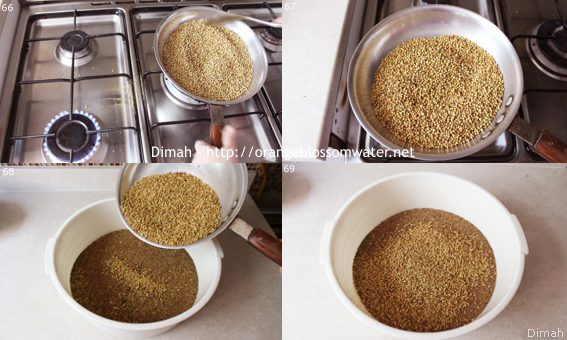
66. When needed, remove from heat for seconds but keep stirring it. This helps to cool it for a little and to prevent burning, then return it back to heat.
67. Roasting coriander seeds (from step 64 – 67) took 3 minutes and 15 seconds for each batch.
52. Transfer roasted coriander seeds to the same bowl of thyme, and set aside.
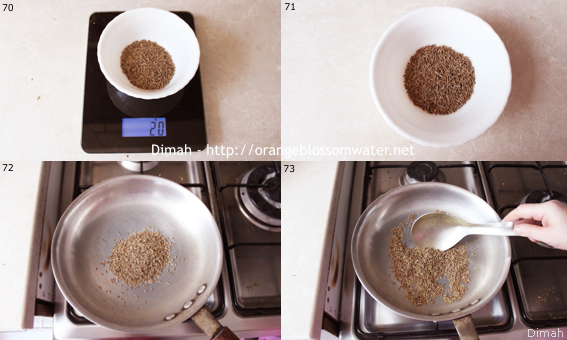
70, 71, 72. To same pan and over medium heat, add 20 g cumin seeds.
73. Stir continuously until fragrant and slightly change in color. Be careful not to burn or change the color too much.
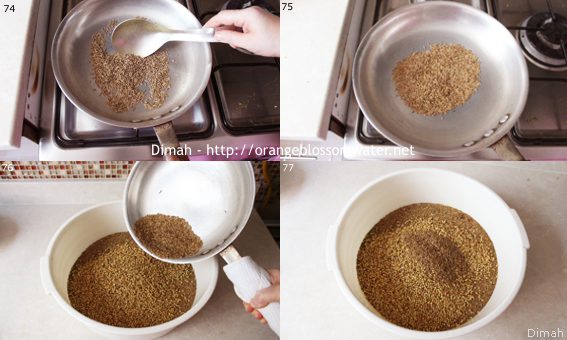
74, 75. Roasting cumin seeds (from step 72 – 75) took 1 minute and 10 seconds.
52. Transfer roasted cumin seeds to the same bowl of thyme, and set aside.
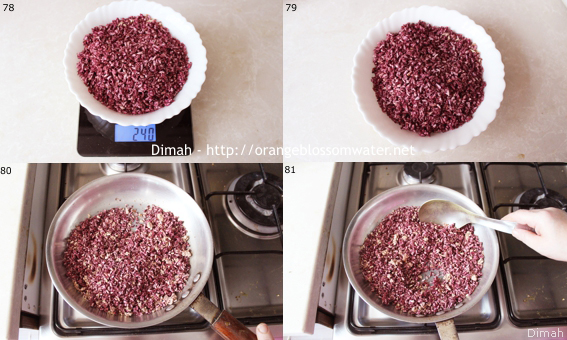
78, 79, 80. To same pan and over medium heat, add in batches 240 g dried pomegranate seeds “Qurtum”.
81. Stir continuously until fragrant and slightly change in color. Be careful not to burn or change the color too much.
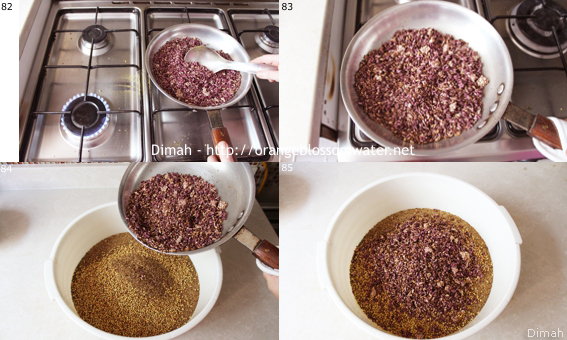
82. When needed, remove from heat for seconds but keep stirring it. This helps to cool it for a little and to prevent burning, then return it back to heat.
83. Roasting pomegranate seeds (from step 80 – 83) took 3 minutes for each batch.
52. Transfer roasted pomegranate seeds to the same bowl of thyme, and set aside.
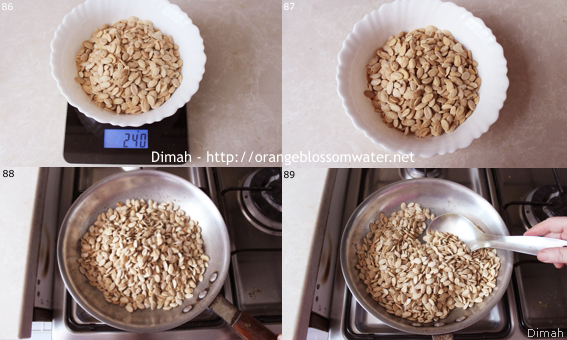
86, 87, 88. To same pan and over medium heat, add 240 g dried watermelon seeds (seeds are with the hard shell, they are not hulled).
89. Stir continuously until turn into light golden in color.
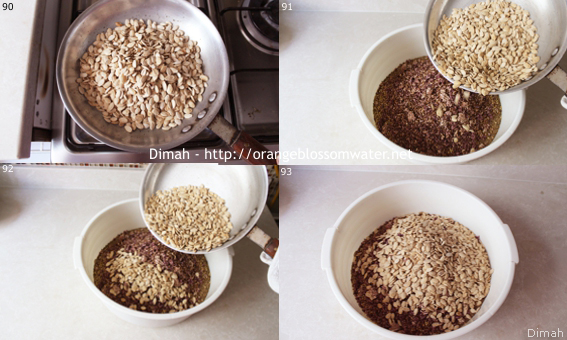
90. Roasting watermelon seeds (from step 88 – 90) took 5 minutes.
91, 92, 93. Transfer roasted watermelon seeds to the same bowl of thyme, and set aside.
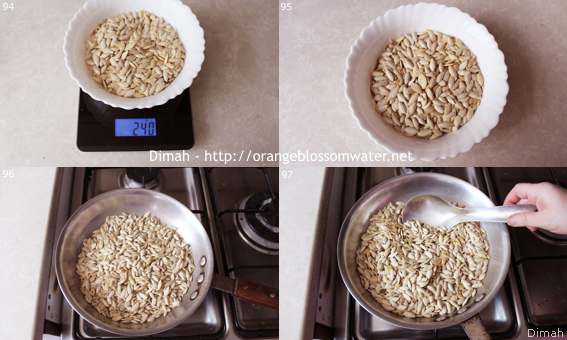
94, 95, 96. To same pan and over medium heat, add 240 g sweet melon seeds (seeds are with the hard shell, they are not hulled).
97. Stir continuously until turn into light golden in color.
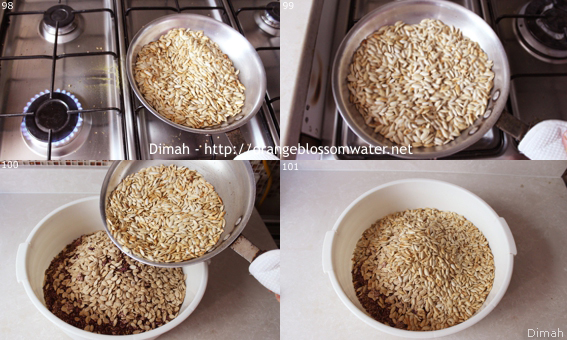
98. When needed, remove from heat for seconds but keep stirring it. This helps to cool it for a little and to prevent burning, then return it back to heat
99. Roasting sweet melon seeds (from step 96 – 99) took 5 minutes.
100, 101. Transfer roasted sweet melon seeds to the same bowl of thyme, and set aside.
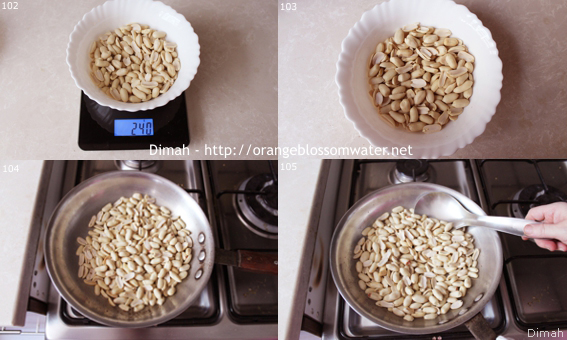
102, 103, 104. To same pan and over medium heat, add 240 g blanched raw peanuts.
105. Stir continuously until turn into light golden in color.
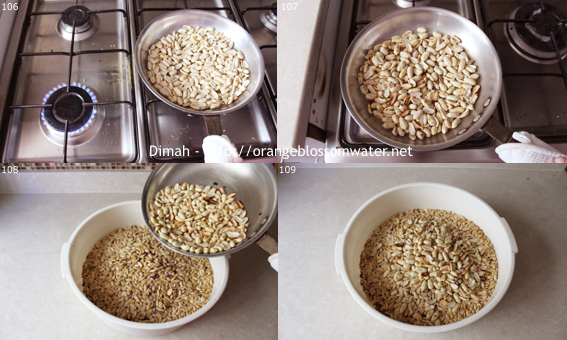
106. When needed, remove from heat for seconds but keep stirring it. This helps to cool it for a little and to prevent burning, then return it back to heat
107. Roasting peanuts (from step 104 – 107) took 5 minutes.
108, 109. Transfer roasted peanuts to the same bowl of thyme, and set aside.
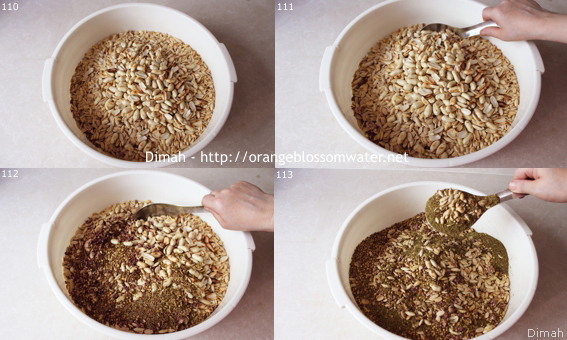
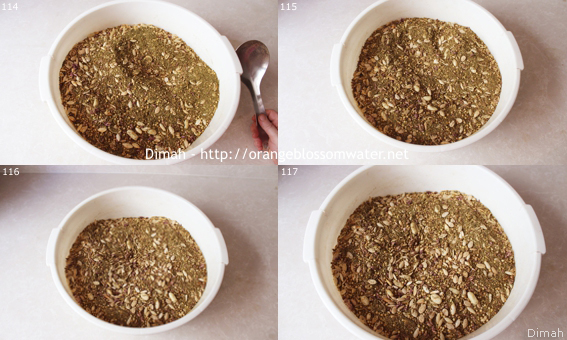
110, 111. The bowl contains roasted thyme, roasted fennel seeds, roasted anise seeds, roasted coriander seeds, roasted cumin seeds, roasted pomegranate seeds, roasted watermelon seeds, roasted sweet melon seeds, and roasted peanuts.
112 – 119. Stir all the ingredients together until mixed.
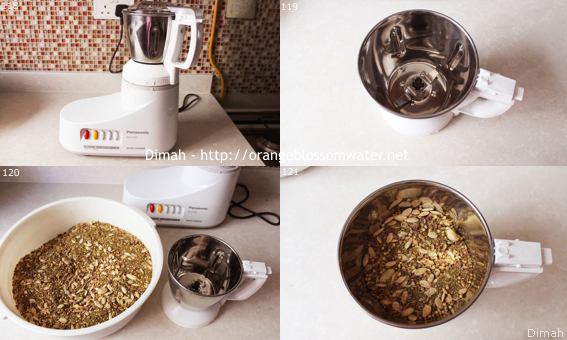
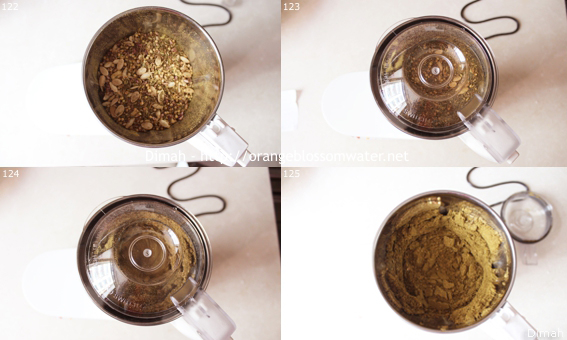
119, 120. Prepare spice grinder.
121, 122, 123, 124, 125. Grind in batches thyme mixture until turns into a fine powder.
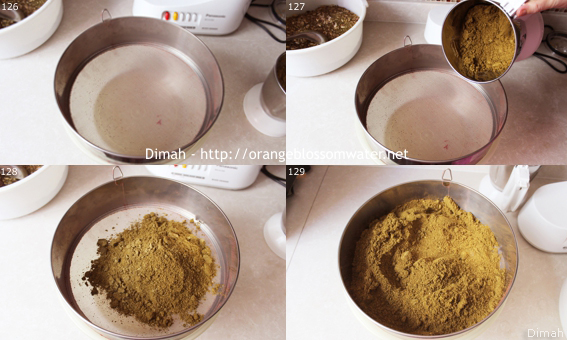
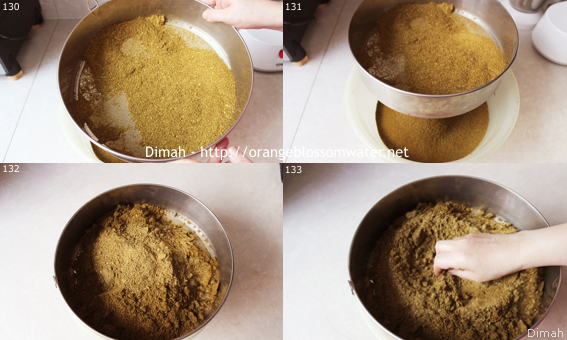
126, 127, 128, 129, 130, 131, 132. Place a sieve over a large bowl, and sift in batches ground thyme mixture.
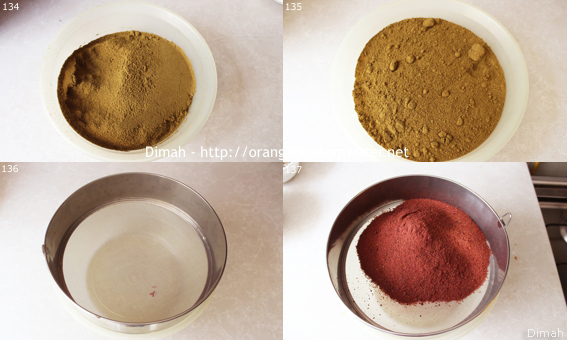
134, 135. Set sifted ground thyme mixture aside.
136, 137. Place a sieve over a large bowl, and sift ground sumac.
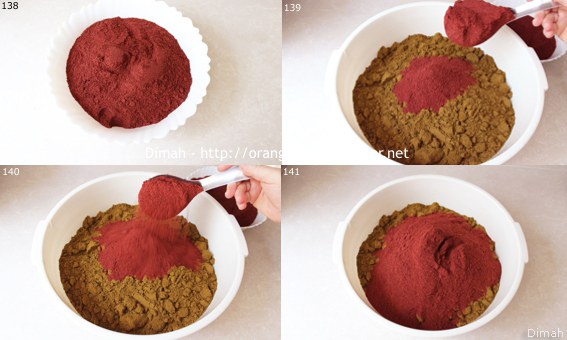
138, 139, 140 ,141. Add 1400 g sifted ground sumac to sifted ground thyme mixture.
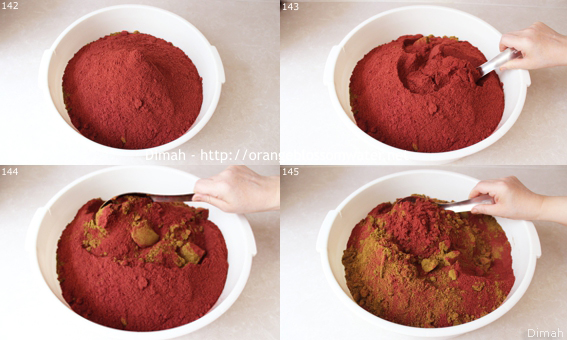
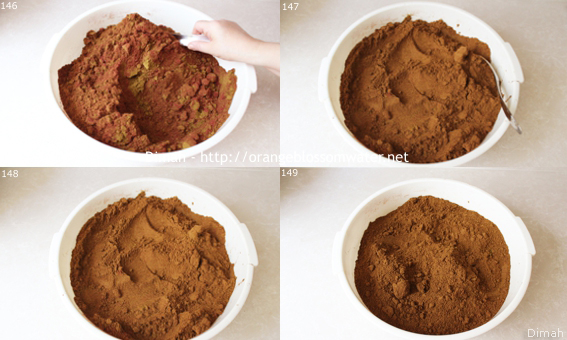
142 – 149. Stir ground thyme mixture and ground sumac until fully mixed, and set aside.
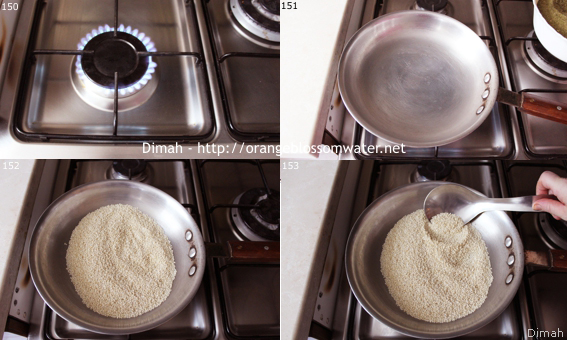
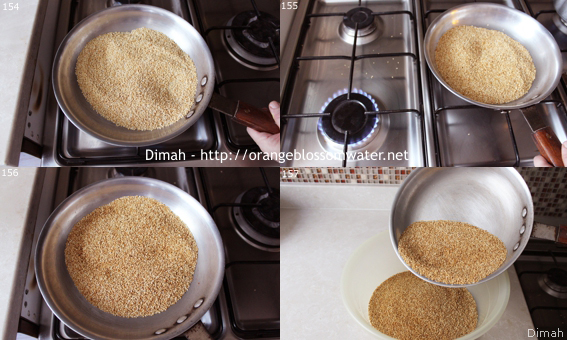
150, 151. Put aluminum pan over medium heat.
152. To the pan, add in batches 1200 g sesame seeds.
153, 154. Stir continuously until turn into golden in color.
155. When needed, remove from heat for seconds but keep stirring it. This helps to cool it for a little and to prevent burning, then return it back to heat
156. Toasting sesame seeds (from step 152 – 156) took 6 minutes for each batch.
157. Transfer toasted sesame seeds to a large bowl, and set aside to cool.
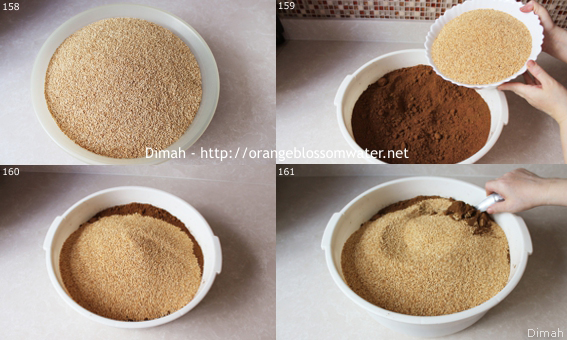
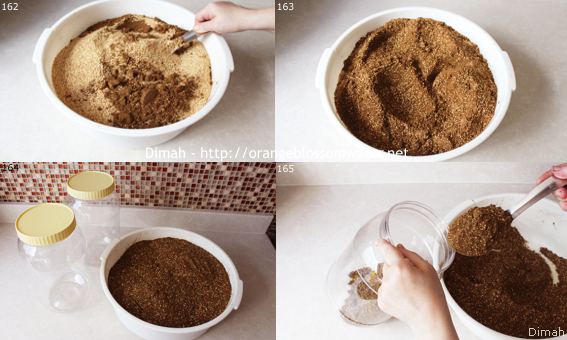
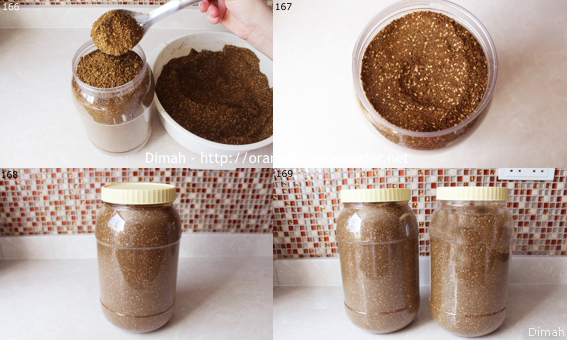
158, 159, 160. Add toasted sesame seeds to thyme mixture.
161, 162. Stir thyme mixture and sesame seeds until fully mixed.
163. Za’atar Halabi “Aleppo Thyme Mix” is ready.
164, 165, 169. Spoon the thyme mixture into large jars.
167, 168, 169. Cover and store in the refrigerator. I always store a small jar at room temperature for daily use.
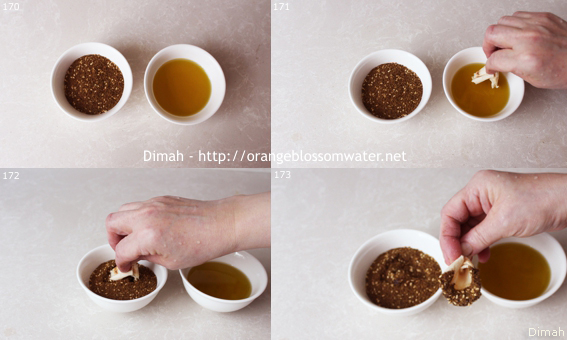
Serving
170. Za’atar Halabi is always accompanied with olive oil “Zeit Az-Zeitoun”.
171, 172, 173. To eat, dip a piece of Arabic flat bread or pita bread in olive oil, then in za’atar.
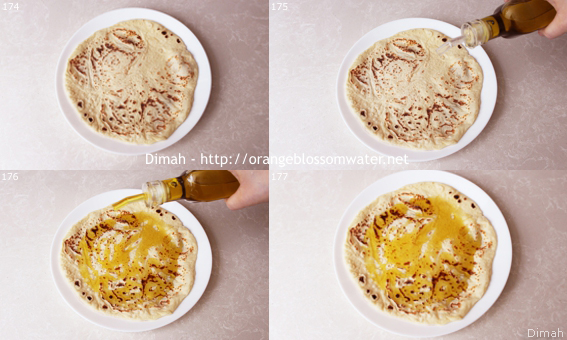
Za’atar Halabi Wrap
174, 175, 176, 177. Bring Arabic flat bread, and drizzle with olive oil
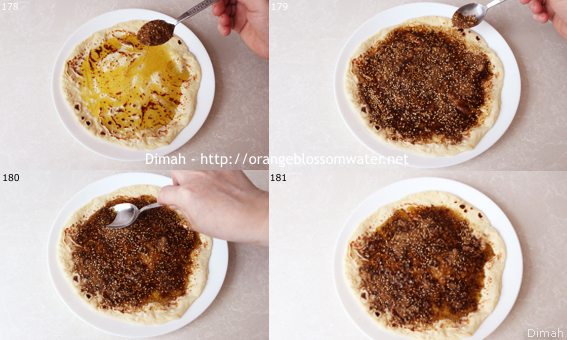
178, 179. Sprinkle with good amount of za’atar halabi.
180, 181. Spread with back of spoon.
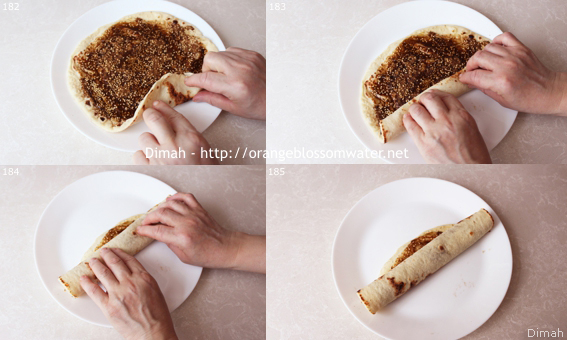
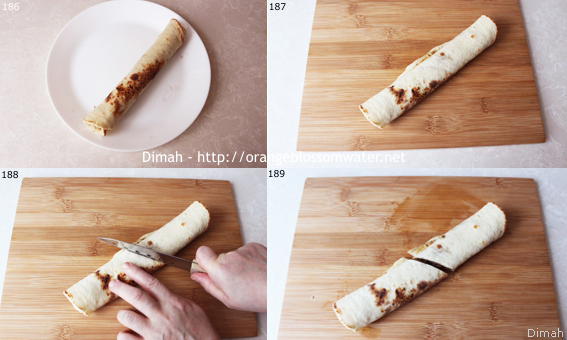
182 – 189. Wrap and serve, or cut in half then serve.
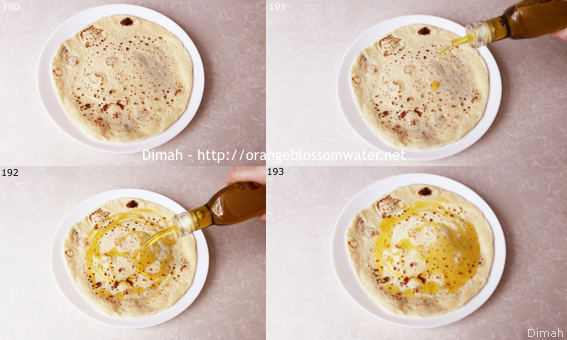
Za’atar Halabi Pomegranate Molasses Wrap
One of the wraps that rarely people in Syria know it, but it is very popular in my family and our favorite.
190, 191, 192, 93. Bring Arabic flat bread, and drizzle with olive oil.
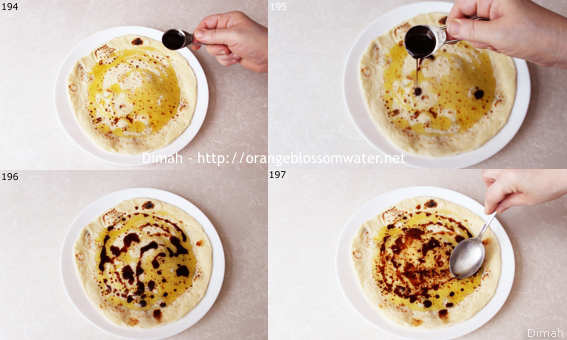
194, 195, 196, 197. Drizzle with 2 teaspoons pomegranate molasses.
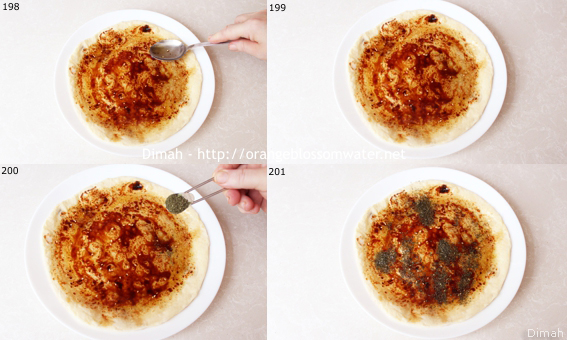
198, 199. Spread with a back of spoon to coat.
200, 201. Sprinkle with 1/2 teaspoon dried mint.
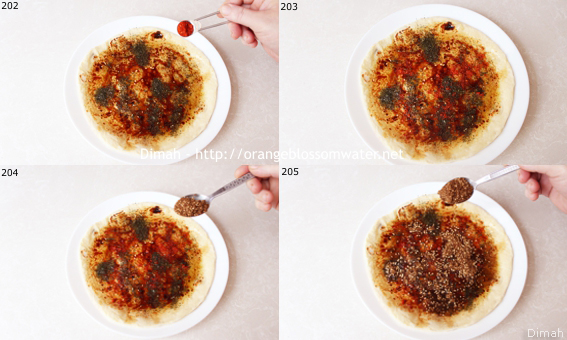
202, 203. Sprinkle with 1/2 teaspoon ground Aleppo pepper.
204, 205. Sprinkle with good amount of za’atar halabi.
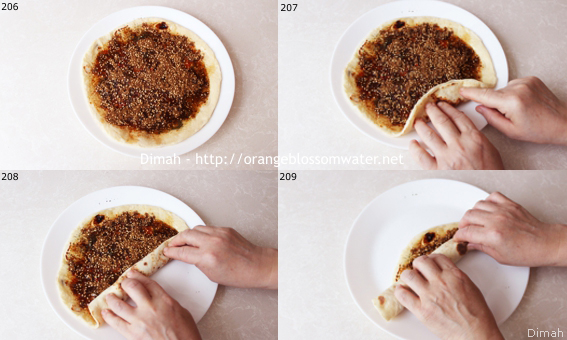
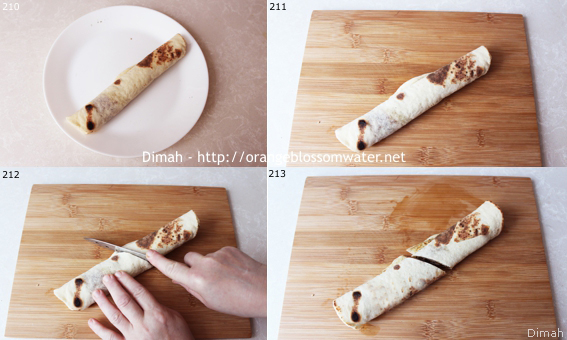
206. Spread with back of spoon.
207 – 213. Wrap and serve, or cut in half then serve.
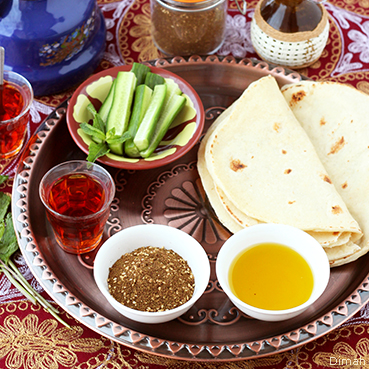
214, 215. Serve Za’atar Halabi with olive oil, Arabic flat bread or pita bread, cucumber and tea. Serve Za’atar Halabi wraps with cucumber and tea.
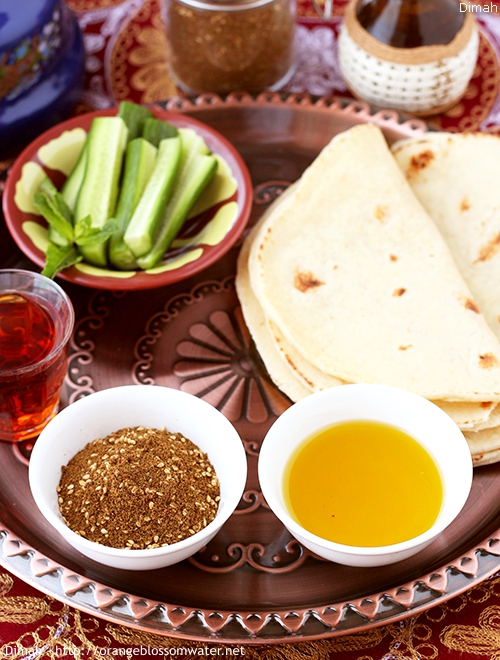

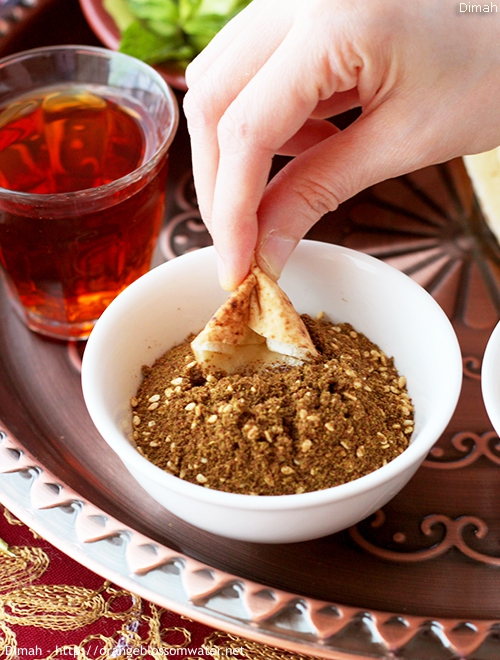
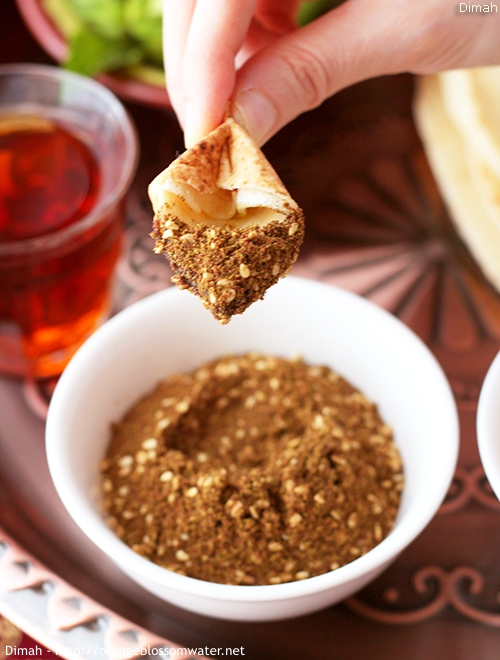
Za’atar Halabi
From: Adnan Bhaia / Servings:
PDF Text Only / Print With Images
| Qurtum (should be prepared few days in advance) 2000 g sour pomegranate Making Za’atar Halabi 360 g dried thyme, roasted 180 g fennel seeds, roasted 180 g anise seeds, roasted 180 g coriander seeds,roasted 20 g cumin seeds, roasted 240 g dried pomegranate seeds “Qurtum”, roasted 240 g dried watermelon seeds 240 g dried sweet melon seeds 240 g blanched raw peanuts, roasted 1400 g sifted ground sumac 1200 g sesame seeds, toasted Za’atar Halabi Wrap Arabic flat bread Olive oil Za’atar Halabi Za’atar Halabi Pomegranate Molasses Wrap Arabic flat bread Olive oil 2 tsp pomegranate molasses 1/2 tsp dried mint 1/2 tsp ground Aleppo pepper Za’atar Halabi To Serve Arabic flat bread Olive oil Cucumber Tea
|
Qurtum (should be prepared few days in advance) Qurtum is dried pomegranate seeds, it is used as ingredient in Za’atar. Bring sour pomegranates, then cut in half crosswise. Then, working over a large bowl and holding one pomegranate half cut side down, smack the fruit with wooden spoon to loosen and release seeds into the bowl. In a blender, add pomegranate seeds. Run your blender few times Place a stainless steel mesh strainer over your bowl and pour the seed mixture through the strainer. Use a spoon to press the pulp against the strainer to extract as much juice as possible. Use your hand and squeeze until you get all juice out. Only seeds are used for Za’atar. Store pomegranate juice for other use. Line a jug with a clean cotton cloth and put the pomegranate seeds inside the cloth, wrap it and squeeze until you get all juice out. Arrange the pomegranate seeds in a single layer on a tray. Put the tray in front of a fan for 24 hours or until seeds dried. 240 g of dried pomegranate seeds is used for the recipe, set aside. Making Za’atar Halabi Put aluminum pan over medium heat. To pan, add in batches 360 g dried thyme. Stir continuously until very fragrant and turn into light brown in color. Be careful not to turn the color into very dark brown. When needed, remove from heat for seconds but keep stirring it. This helps to cool it for a little and to prevent burning, then return it back to heat. Roasting dried thyme (from step 38 – 42) took 3 minutes and 30 seconds for each batch. Transfer roasted thyme into a large bowl, and set aside. To same pan and over medium heat, add 180 g fennel seeds. Stir continuously until fragrant and slightly change in color. Be careful not to burn or change the color too much. When needed, remove from heat for seconds but keep stirring it. This helps to cool it for a little and to prevent burning, then return it back to heat. Roasting fennel seeds (from step 48 – 51) took 4 minutes Transfer roasted fennel seeds to the same bowl of thyme, and set aside. To same pan and over medium heat, add 180 g anise seeds. Stir continuously until fragrant and slightly change in color. Be careful not to burn or change the color too much. When needed, remove from heat for seconds but keep stirring it. This helps to cool it for a little and to prevent burning, then return it back to heat. Roasting anise seeds (from step 56 – 59) took 3 minutes and 15 seconds. Transfer roasted anise seeds to the same bowl of thyme, and set aside. To same pan and over medium heat, add in batches 180 g coriander seeds. Stir continuously until fragrant and slightly change in color. Be careful not to burn or change the color too much. When needed, remove from heat for seconds but keep stirring it. This helps to cool it for a little and to prevent burning, then return it back to heat. Roasting coriander seeds (from step 64 – 67) took 3 minutes and 15 seconds for each batch. Transfer roasted coriander seeds to the same bowl of thyme, and set aside. To same pan and over medium heat, add 20 g cumin seeds. Stir continuously until fragrant and slightly change in color. Be careful not to burn or change the color too much. Roasting cumin seeds (from step 72 – 75) took 1 minute and 10 seconds. Transfer roasted cumin seeds to the same bowl of thyme, and set aside. To same pan and over medium heat, add in batches 240 g dried pomegranate seeds “Qurtum”. Stir continuously until fragrant and slightly change in color. Be careful not to burn or change the color too much. When needed, remove from heat for seconds but keep stirring it. This helps to cool it for a little and to prevent burning, then return it back to heat. Roasting pomegranate seeds (from step 80 – 83) took 3 minutes for each batch. Transfer roasted pomegranate seeds to the same bowl of thyme, and set aside. To same pan and over medium heat, add 240 g dried watermelon seeds (seeds are with the hard shell, they are not hulled). Stir continuously until turn into light golden in color. Roasting watermelon seeds (from step 88 – 90) took 5 minutes. Transfer roasted watermelon seeds to the same bowl of thyme, and set aside. To same pan and over medium heat, add 240 g sweet melon seeds (seeds are with the hard shell, they are not hulled). Stir continuously until turn into light golden in color. When needed, remove from heat for seconds but keep stirring it. This helps to cool it for a little and to prevent burning, then return it back to heat Roasting sweet melon seeds (from step 96 – 99) took 5 minutes. Transfer roasted sweet melon seeds to the same bowl of thyme, and set aside. To same pan and over medium heat, add 240 g blanched raw peanuts. Stir continuously until turn into light golden in color. When needed, remove from heat for seconds but keep stirring it. This helps to cool it for a little and to prevent burning, then return it back to heat Roasting peanuts (from step 104 – 107) took 5 minutes. Transfer roasted peanuts to the same bowl of thyme, and set aside. The bowl contains roasted thyme, roasted fennel seeds, roasted anise seeds, roasted coriander seeds, roasted cumin seeds, roasted pomegranate seeds, roasted watermelon seeds, roasted sweet melon seeds, and roasted peanuts. Stir all the ingredients together until mixed. Prepare spice grinder. Grind in batches thyme mixture until turns into a fine powder. Place a sieve over a large bowl, and sift in batches ground thyme mixture. Set sifted ground thyme mixture aside. Place a sieve over a large bowl, and sift ground sumac. Add 1400 g sifted ground sumac to sifted ground thyme mixture. Stir ground thyme mixture and ground sumac until fully mixed, and set aside. Put aluminum pan over medium heat. To the pan, add in batches 1200 g sesame seeds. Stir continuously until turn into golden in color. When needed, remove from heat for seconds but keep stirring it. This helps to cool it for a little and to prevent burning, then return it back to heat Toasting sesame seeds (from step 152 – 156) took 6 minutes for each batch. Transfer toasted sesame seeds to a large bowl, and set aside to cool. Add toasted sesame seeds to thyme mixture. Stir thyme mixture and sesame seeds until fully mixed. Za’atar Halabi “Aleppo Thyme Mix” is ready. Spoon the thyme mixture into large jars. Cover and store in the refrigerator. I always store a small jar at room temperature for daily use. Serving Za’atar Halabi is always accompanied with olive oil “Zeit Az-Zeitoun”. To eat, dip a piece of Arabic flat bread or pita bread in olive oil, then in za’atar. Za’atar Halabi Wrap Bring Arabic flat bread, and drizzle with olive oil Sprinkle with good amount of za’atar halabi. Spread with back of spoon. Wrap and serve, or cut in half then serve. Za’atar Halabi Pomegranate Molasses Wrap One of the wraps that rarely people in Syria know it, but it is very popular in my family and our favorite. Bring Arabic flat bread, and drizzle with olive oil. Drizzle with 2 teaspoons pomegranate molasses. Spread with a back of spoon to coat. Sprinkle with 1/2 teaspoon dried mint. Sprinkle with 1/2 teaspoon ground Aleppo pepper. Sprinkle with good amount of za’atar halabi. Spread with back of spoon. Wrap and serve, or cut in half then serve. Serve Za’atar Halabi with olive oil, Arabic flat bread or pita bread, cucumber and Tea. Serve Za’atar Halabi wraps with cucumber and tea. |
Notes and Tips
The pan used should be aluminum.
There are lots of varieties of thyme. But unfortunately I couldn’t specify the generic name for the thyme we use to make Za’atar, click here for close up to see the dried thyme I used. Please notice that only this type of thyme is used to make Za’atar, and any other type is not suitable and will ruin the taste.
Roasting the spices and nuts is done to dry them up and that will help in grinding, therefor be careful not to burn them or change the color too much.
When roasting the spices and nuts you may need to do that “in batches” and you may do not need that, of course it depends on the pan’s size, which is why in some cases I mentioned that I did it “in batches”.
I used light brown dried watermelon seeds, but black dried watermelon seeds could be also used.
Dried watermelon seeds are used with their hard shell, click here to see.
Dried sweet melon seeds are used with their hard shell, click here to see.
You will need a large spice grinder like the one I used, click here to see the model.
Here is a photo of ground Aleppo pepper, and click here to know more about it.
Here is a photo of Za’ater in Al-Madina Souq. Here is a photo of Al-Naser Za’atar, one of famous brands in Aleppo.
Check my video:
Making Za’atar Halabi
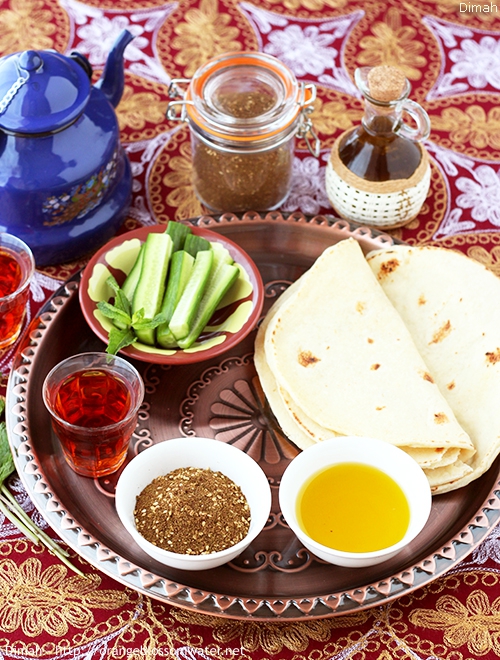
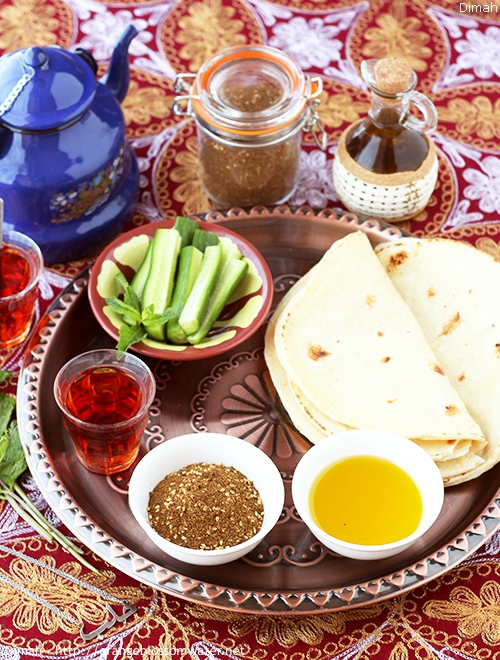

Thank you so much for sharing all those wonderful recipes!!!
Thanks so much for sharing and for the detailed instructions!
Hello Dimah,
I have never seen fresh sour pomegranates in my area, only sweeter varieties.
Do you have any advice on this matter? Perhaps I could stay on the lookout for an arrival of sweet pomegranates that are a bit on the sour side? Perhaps choosing the less ripe ones would help?
I would also appreciate if you could tell me if the pomegranate powder has a name in Arabic that I could use to search for pre-ground pomegranate seeds in case there’s no way to use fresh ones.
Hello Elias
Sour pomegranate adds flavour and tartness. For now, use sweet pomegranate and add more sumac if needed.
In Syria, the name of Pomegranate seed is Qurtum قرطم, The powder is Qurtum Matthoun قرطم مطحون
Ι do not think you will find it, even in Syria nobody sells pomegranate seeds or its powder
Thank you so very much Dimah.
When I wrote you this message I had finally found good quality sweet melon seeds, so this was the only missing piece to finally be able to make this type of za’atar for me and my relatives. We fought very hard to bring them into our second country so they could raise their children peacefully, and I’m sure that a taste from home will bring them joy.
Your website is one of my treasures.